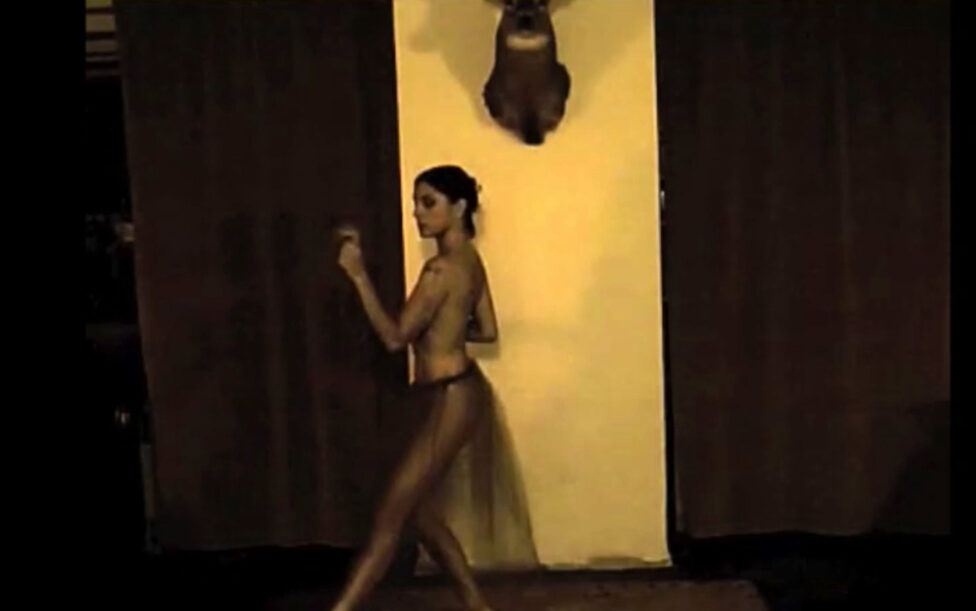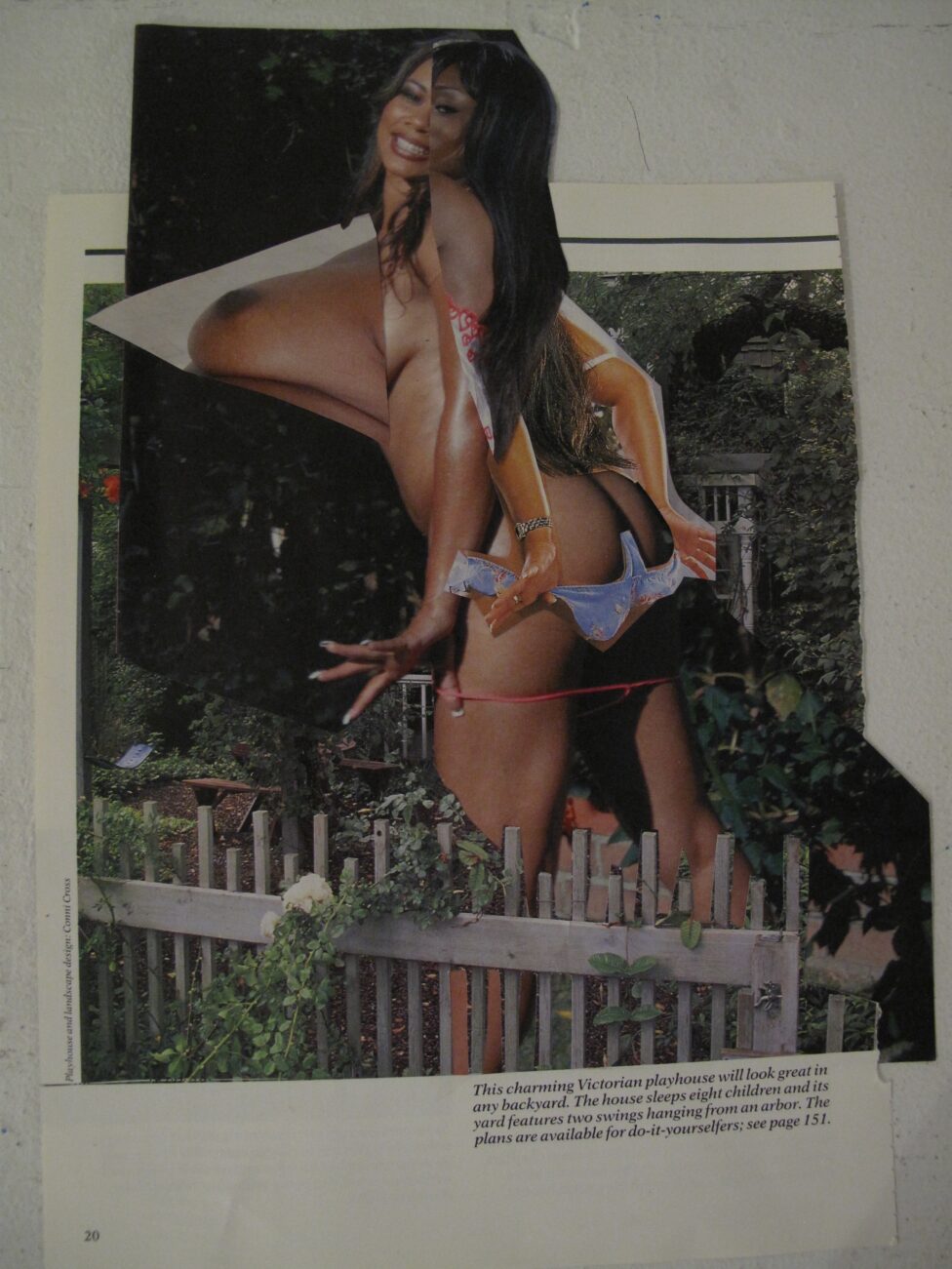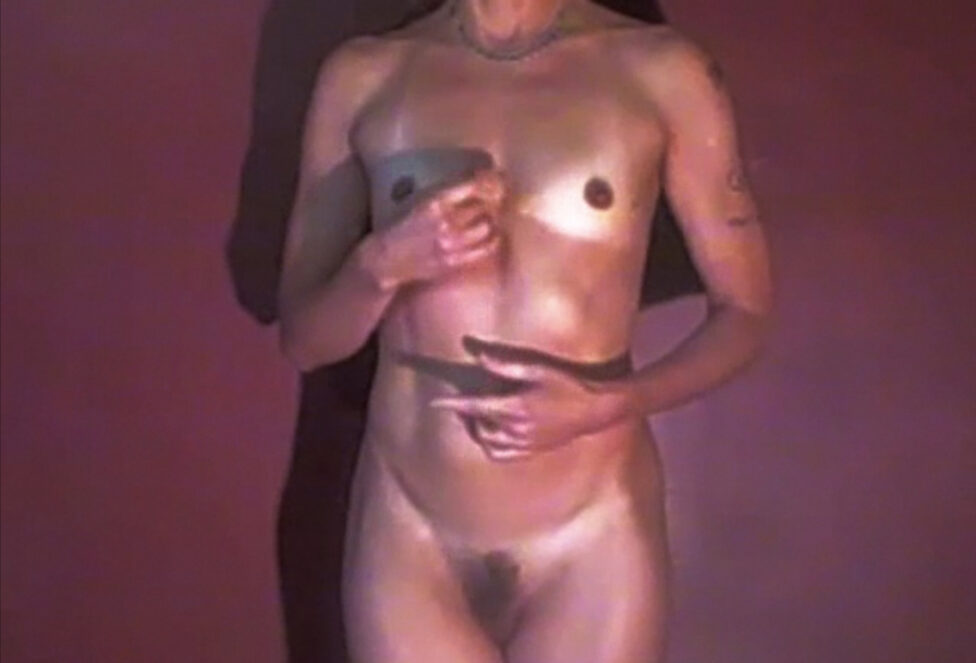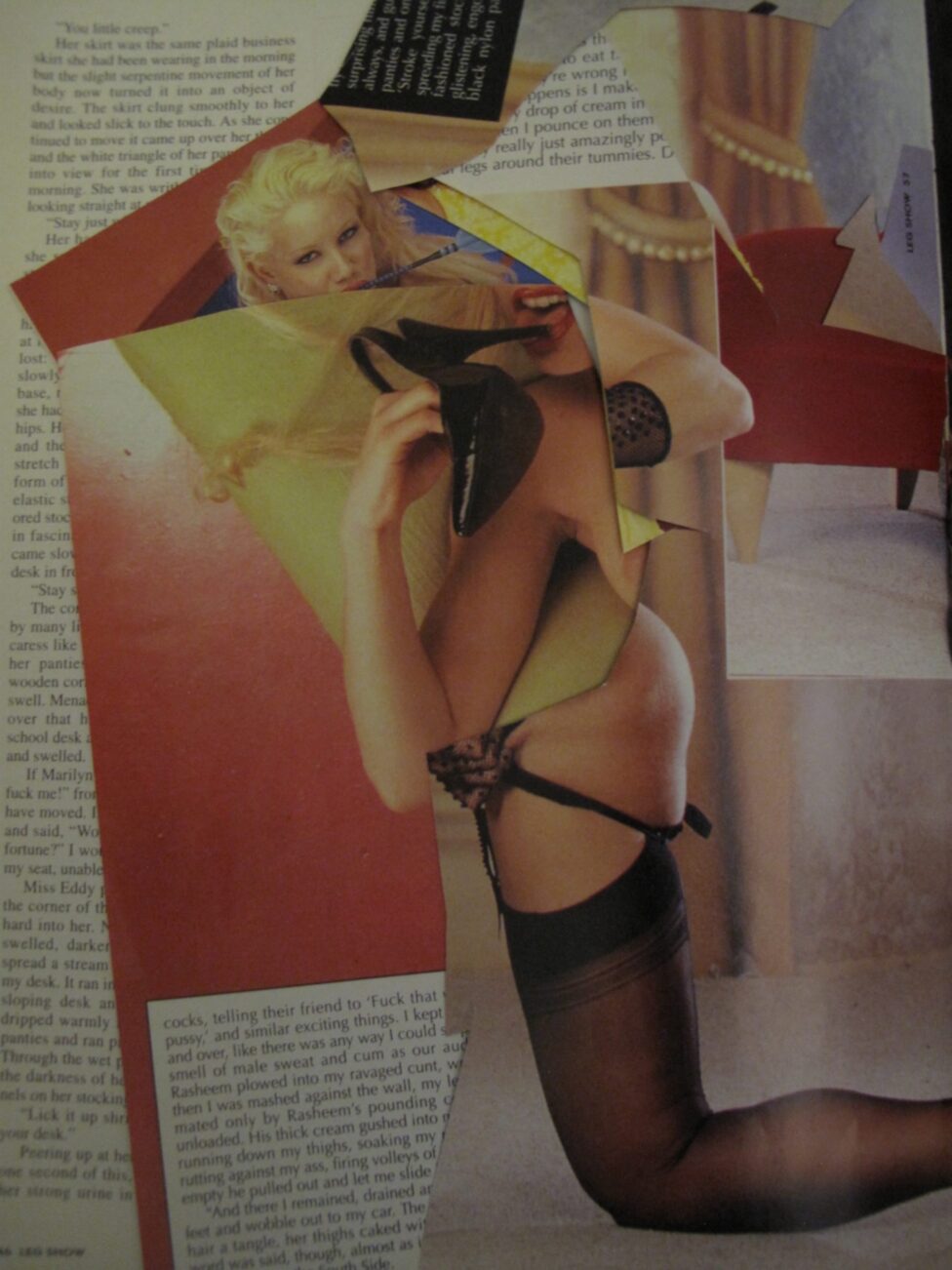Narcissister: It’s so lovely to reconnect with you. It’s really been a while.
Barbara Browning: Yeah, I’m anxious to hear what you’ve been up to. Should we just launch into this?
N: Yes, yes.
BB: Okay. I want to catch up with you personally. But then again, there are these questions. Since it’s for Movement Research, they seem to be interested in the ways that people whose work entails dance and performance have been dealing with things since the performance venues have shut down. So if you care to talk about that?
N: I’m open to talking about it. I feel grateful that I was performing right up until the shutdown. I was in Europe, performing in London, at The Box. I was also in Paris, I did a big performance in the main hall at the Pompidou Center, opened up by a talk by Paul Preciado. I was just totally so honored to be there. And the main hall was completely sold out. They even had to create an overflow room where there was a bunch of other audience members and they had the performance live streamed to that overflow room. I feel so grateful that I was able to be out in the world just before things shut down. My flight was already booked to come back to New York on March 15. And I think the border closed on March 16. So I was able to be out in the world performing a lot and be out around people and performing for crowds. And just the funny thing about it at that moment, I was the only one wearing a mask! But it was my Narcissister mask.
BB: And the Pompidou performance was when? When did that take place?
N: Was it March 10? Just before things shut down, I took the train from London to Paris and back. So I was able to do these things that we think twice about or we don’t do at all now. I feel really grateful that I haven’t been sick, and no one in my family has been sick. So the shutdown itself has really been such a wonderful opportunity to slow down and to regroup and breathe and work on new material.
BB: So you didn’t have any performances that were planned that had to be canceled?

Video still by Barbara Browning
ID: A video still of a nude woman wearing a knee-length black tulle skirt, facing left and looking low in front of an extended left foot with the weight shifted on a bent right leg. She is holding and object up and close to her gaze in the left hand with the other bent elbow cocked back behind her.
N: I did. I have a list. And I was able to use that list to apply for two artist Emergency Fund grants. And the wonderful thing is that part of those applications is to submit a list of all of the events and bookings that you had that were cancelled. So at least I was able to make lemonade from lemons in that form, but it’s challenging financially and I’m collecting unemployment. It’s so little but the emergency grants help, and I’ve done a few online artist talks. One for UC Santa Barbara and the other one for CalArts. It’s wonderful to have those opportunities to continue to present my work and to connect with students in that form. So, all in all, it’s been a gift. I don’t take that lightly because I know that it’s incredibly scary and stressful and even tragic for so many people.
BB: So the residency you have now is where?
N: It’s in Kingston, New York. I was delighted that it’s still happening. I got another residency at the Bemis Center in Nebraska, and that has been postponed until 2022. This one is small, and there’s COVID protocol where each resident had to get tested before arrival. And there’s no non-residents allowed in the house. It’s lovely to be coexisting with new people, preparing and eating meals together and just sitting next to people without fear or without masks is really a treat.
BB: And you’re making…? The residency is to make new work while you’re there?
N: Yeah.
BB: Are you working with video? How are you making it?
N: I’m not working with video. Here, I am working on new live performance work. So I’m making the costumes and working out the narrative. It’s wild to make stuff with no idea of when I might possibly be able to present it. I definitely feel like my inspiration comes from having a deadline or having a show that I want to finish something for. So not knowing that, it does feel a little random, a little scary. But I love making those works. And I do look forward to performing again when it’s possible. So it feels like a good use of my time. And I enjoy it. Then I’m also working on collage works.
BB: Collage meaning physical objects?
N: Yeah, it’s always been an aspect of my Narcissister project since the beginning but not as well known. I make collages with paper that I either glue together or I photograph them and then they exist as a photographic print. They explore a lot of the same themes of the other aspects of my project. Plus they’re just a fun, less intensive creative process than the performance work, or the rehearsals, or even making a film.
BB: So the situation hasn’t really changed. I guess many of us are trying to explore video or other media more due to the circumstances. You’re just bashing ahead with your old modus operandi. There’s something very beautiful about that because you’re just plowing ahead working towards the day when you can do live performances, as opposed to completely shifting gears and changing your strategy There’s something encouraging about somebody just holding to their way of being.
N: I appreciate it. I mean, I definitely thought twice about it. Because even with this opportunity to come for this residency where I’ll be for a month, and it’s a totally new setting, new workspace, new people. I was able to get a ride up here so I could bring whatever I wanted in terms of materials. I thought, you know, do I create an agenda for myself where I do exactly what you’re saying? Explore new territory where I make some physical artworks that are more saleable than my other works? Even something that’s very tasty and aesthetically pleasing and has some politics to it but can also be something to hang above a fancy living room couch. So I’ve thought how can I get my hustle on a little more as an artist these days when I’m not making money performing? Also, with technology, would I explore creating live stream performance events? I never post to my Instagram, would I finally give in and post little snapshots of Narcissister? I’m not clear about either of those paths and I would like to think that even with the new performance works that I’m working on if I do decide to present them as videos, at least they will be ready. The piece will be worked through so that it could be captured with video.
BB: You’ve done work in video on film before, and that’s part of your arsenal. But it’s interesting that it’s not the primary mode right now because that’s where a lot of people seem to be turning.
N: Right, right. Well, for example, I had this wild opportunity to quarantine with art dealer Jeffrey Deitch in LA for a couple of months this summer. I proposed to him that I shoot a film about this experience of traveling to LA to quarantine together in his house, which was one of Cary Grant’s houses at a time when he was closeted and having a love affair with a fellow gay actor. And Paramount or whatever major studio he was working with forced him to marry a woman as a cover up. There was a public marriage and the woman moved into the house with Cary Grant and his male lover. That’s the house that I was quarantining in. I haven’t started editing it yet, but I did shoot that whole process, and it was very much about masks: the mask that Cary Grant was wearing, my Narcissister mask, COVID masks, the mask of Jeffrey Deitch as a public figure that he inevitably wears when he’s not in private. And my experience of him, without a mask, metaphorically.
BB: Literally and figuratively.

Photo by Narcissister, “Untitled San Antonio Collages (Garden)” (2019)
ID: A collaged image of several body parts forming a nude Black woman facing away, smiling over her left shoulder while mooning us with purple-flowered panties, all in a lush green garden with a wooden slatted fence in the foreground.
N: Yeah, but because I don’t have income from my performance work, which I generally use to fund all of my creative projects, including the films, I’m on hold with that film.
BB: So I guess I should ask you a little bit about dance, since this conversation is a Movement Research initiative. I mentioned to you when we were first planning to have this conversation, that I’ve been teaching online. One of the classes that I’ve been teaching is “The Performance of Everyday Life,” which was kind of great to teach under these circumstances because everybody now, in front of their computer, on the Zoom screen is very self-conscious about the performance of their participation in a seminar and so on. The class syllabus was arranged around the text by Marcel Mauss called “Techniques of the Body.” He says that everything in everyday life is basically choreographic or technical. At the time I was teaching sex as a choreographic act and of course, I was thinking of you, and wondered what you thought about that.
N: I’d love to hear more about what you taught, like how you approached that.
BB: I had them read some theoretical texts and some dance ethnographic texts that talk about sexuality in dance in relation to you know, “real sex.” But Mauss has this beautiful line in his essay when he says there’s nothing more technical than the sexual position, like there’s nothing that is more dancerly than that particular activity. And so when I said that people are very self-conscious about their performance of everyday life, that includes sexual contact. Now, unless you happen to be a person who’s in a pod with a sexual partner, the virtual space is the space for that to happen, whether it’s through visual images or language or video, and dancing too. For me, I am somebody who happens to have the good fortune of being in a pod with a partner.
N: Lovely, yes, lovely.
BB: I’m very thankful for certain aspects of the way that this has played out in my own life. And that’s certainly one of them. Despite that, we have had long periods of separation where a lot of our interactions are virtual, including sexual ones. So that’s not unfamiliar to me. But for many of my students now that’s a somewhat new reality. Dance is another thing that for me has often been mediated by technology and performed on the internet. Most of my choreographic or dance practice for years has been making these very tiny, what I call “chamber choreographies,” in the privacy of my own little, tiny living space. So, those two things for me are a very familiar way of both dancing and of having an erotic life. It’s something that I’ve been thinking about for a long time but it seems like for many people that’s what’s happening now. And I have a number of my students who are involved in dance trying to figure out how they can collaborate or dance together online. The most beneficial use of Zoom that I’ve had during this whole period has been having silent raves with my students.
N: Whaaaaaaaat!
BB: Which have been the most productive ways that I found to use all of this. But just the other day my colleague, Michelle Castañeda ran a little workshop to see if we could all do a choreography together on Zoom. You know, dancing together, but improvisational. And part of the reason I like the silent rave mode, is because there’s always that little lag time. So any kind of musical or choreographic thing on Zoom or FaceTime or anything like that are always a little out of sync. So just the pure pleasure of people sort of sharing their own pleasure and dancing, even if they’re out of sync, and they’re alone but they’re alone together, that’s the most useful thing that I found about all of this.
N: Wow, that sounds wonderful. And then each student picks their own music to sort of rave to?
BB: Exactly, exactly.
N: And how long does this rave go on for?
BB: I don’t know, I’ve done it a couple of times. I’ve done it for 20 minutes. I’ve done it for an hour. And sometimes people type into the chat what music they’re listening to so somebody else will turn that on. They’re obviously not exactly in sync so…
N: Wow, gosh. Lucky students to be working with you. That sounds so wonderful.
BB: No, lucky me because they’re really great and they seem to be game. They’re up for it. But they’re all trying to figure out how to be alone together you know, together alone. And dance is a pretty interesting way to think about that, sex too. But that’s obviously outside of the parameters of my teaching.
N: Well, not really! It sounds like you did a week on sex.
BB: Yeah. You know, theoretical. [laughter]
N: Right. Right. Wow, that sounds very reflective of our times and very supportive. Yeah, wonderful perspective on this world that we’re living through, or we’re living in right now.
BB: So are you dancing much these days?
N: I do home dance parties of one. It’s wonderful to still listen to music, still move my body to music. When I was performing a lot at The Box or other nightclubs, I could stay in the know about raves and when they’re happening. I love techno music and I really love dancing to pop music also. I miss being in the know about who the current pop stars are and what the hit songs are. So I’m making little attempts to stay up to date. And, I’m enjoying dancing too.
BB: Yeah, when this first started, my initial impulse was just to dance every day. My poor partner had to live with my insistence that we turn out the lights and dance really hard. I made a few videos, but you know, I’m prohibited from sharing those because he’s on them [laughter]. But a lot of Courtney Love, a lot of rocking out. And that was really, really important in the very beginning, when we were just really kind of terrified, you know? And there was something very reassuring about that. Eventually we kind of slacked off. I continue to try to have a little bit of a dance practice every day. Definitely yoga and all of those other things to take a break and get away from the computer. But I should probably get back to dancing. The turning-out-the-lights-and-really-rock-out more.
N: Even for a few songs. It can be a short session and feel so nice. So were you both in the same country when the shutdown happened?
BB: Yeah, we were in New York.
N: Well, that’s lucky.
BB: Exactly. And it’s been really hard for him, because he’s been basically exiled from France for a year. So we’re essentially hoping to get back. But he’s 68 and he has emphysema. So that means we have to be super, super careful. But another aspect of this whole thing has been this sense of being a compound organism with four lungs, and two of them are compromised. It’s something that I’ve thought a lot about, and is very real to me independent of all of this but it really brings it home. So, you know, so the whole notion of where the body begins and ends during this kind of shifted.
N: That’s beautiful.
BB: Yeah I mean, it’s beautiful. It’s beautiful to recognize that your body doesn’t end where you think it ends, but it’s also a little scary.
N: Scary because of your concern for him.
BB: Well also there’s something inherently beautiful and scary about understanding that it’s not strictly in relation to a sexual partner. It can be a family member or anybody that you’re in the pod with. But there is something simultaneously very beautiful and a little frightening to not feel totally independent in the world, like a discrete object that can kind of control its environment.
N: Our interdependent-ness is scary and the responsibility of that. Yeah. And so aside from the teaching, are you writing still?
BB: Yes. Right. I wrote a manuscript during this period, which was about miniatures. It started out before the pandemic hit. I had this project that I was going to write about miniature things. And that also suddenly seemed very appropriate, you know, little tiny things in the constrained space.

Video still by Barbara Browning
ID: a toned brown body with triangle bikini tan lines, elbows bent and hands in front of the body with hands in mid-gesture, standing against a purple-red backdrop in a harsh spotlight, and cut off at the neck and just below the pubis
N: That’s awesome. So then you’re staying mostly Upstate?
BB: We came upstate in mid September. We’ll be here for a while.
N: Wow, cool. And you already had a place upstate or you got one?
BB: Oh, no, no, we got one. Just as you know, it was something we never would have thought about doing under other circumstances. But suddenly, you know. Like you, I feel very lucky.
N: Very cute there. Yeah.
BB: We’re really, really in the country. Super isolated which is, you know, it’s great. For me, it’s a little melancholy. For him, he’s used to living in the country in France, but it’s a little strange for me. But also very beautiful. So all of those things that you said about time to slow down and contemplate things? I’m feeling that.
N: And how’s your son doing?
BB: He’s okay, he just went back to New York. You know, I think it’s really hard for the very young people who really want to have a social life. He’s also a musician. So once again, he enjoys sharing those things in public space.
N: Um, I have something to also thank you for, which is that I was in an exhibition last fall, a group show in LA that Karen Finley was also in. I remember that I initially connected with her, maybe it wasn’t the very first time, but it was at a thing that you organized, at NYU?
BB: The launch of my book, yeah, that you both read from.
N: That’s what exactly it was! Yeah! And I ended up having an issue come up with a gallery and she has been so supportive of me. And really shared her wisdom in dealing with these kinds of things, and was willing to do a phone call with me, and follow up. I really appreciated her support and it was just fun and exciting to talk to her. Thank you for that.
BB: Oh, I imagine because you’re both great! So I’m really glad you connected. I’m just really delighted to hear that you’re still plugging away and making beautiful things. So it’s very encouraging with this hope for light at the end of the tunnel.
N: Yes, I do think there is light at the end of the tunnel, and I’m so excited to hear that about you too! That you’re doing your dancing and even capturing some videos and that you’re working on your writing and navigating teaching in this new era. Really, again, it just sounds so fascinating. So apropos.
BB: Well my students are really the ones who have kept me emotionally afloat because they’re still hungry, they’re still curious. Hats off to them, because it’s easy to get exhausted and sad, but they’re still at it.
N: Yes. I so look forward to when we meet again in person.
BB: Me, too.
N: I love your concerts. I remember the concert at Dixon Place.
BB: We’re hoping we can do that again.
N: Yeah, I look forward to that. Cool, okay. I’d love to be in touch in whatever capacity is in the flow.
BB: Yeah, I’d love that.
N: All right, Barbara, you take care.
BB: Bye.
Cover image description:
A collage made from magazine clippings of a blonde woman with an arrow in her mouth looking direct and sultry, covered by a close up of a mouth licking the heel of a black stiletto, hovering above a single kneeling stockinged leg, all atop pages from an adult novel.





